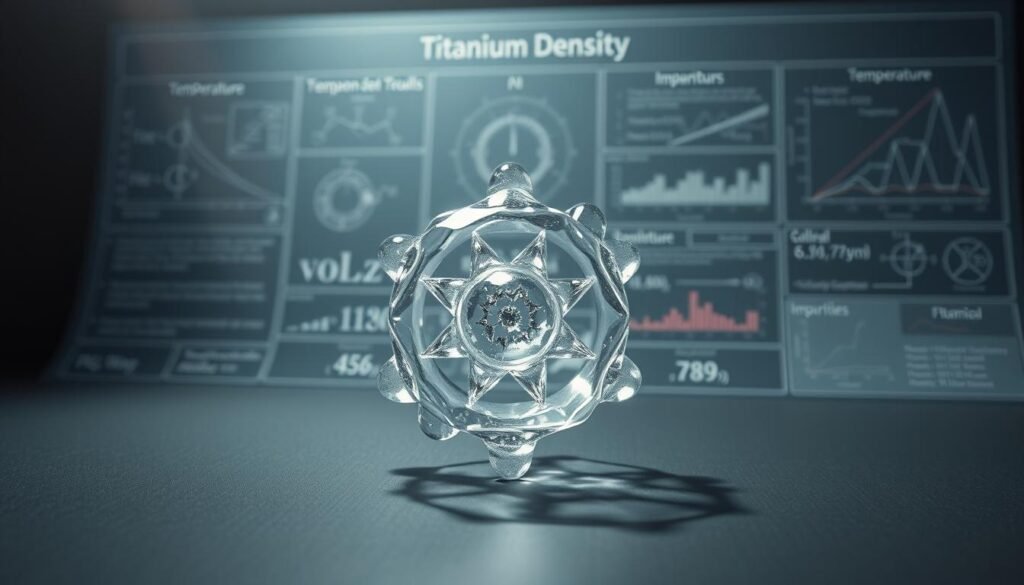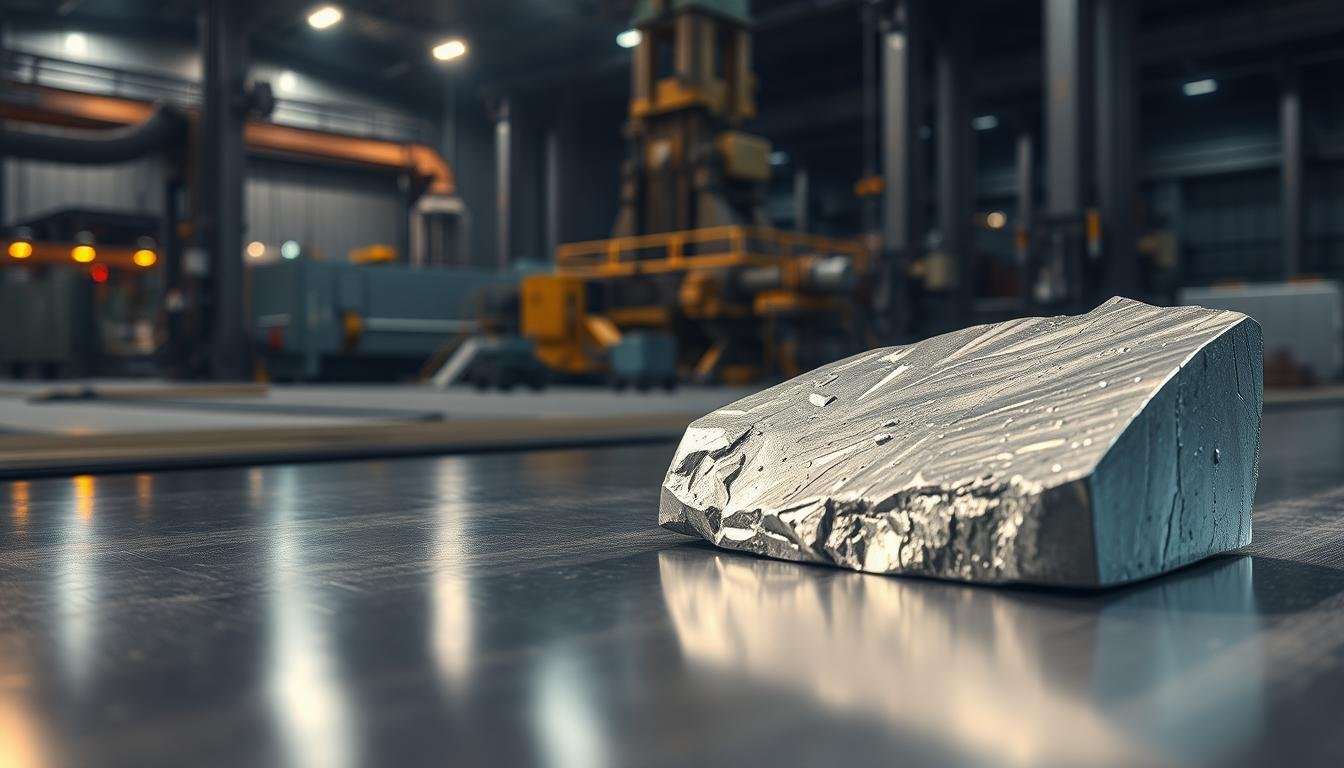Knowing about titanium density is key in many fields like aerospace, automotive, and medicine. Titanium is strong and light, making it great for engineering. It also doesn’t corrode easily, which is a big plus in tough settings.
This article will cover the science behind titanium density and its alloys. We’ll see how these aspects affect performance and material choice in engineering and design. For more details, check out this resource on titanium density. It dives deep into its importance across different industries.
What is Titanium Density?
Titanium density is key to understanding this metal’s properties and uses. It measures the mass of titanium in a given volume, usually in grams per cubic centimeter (g/cm³). Pure titanium has a density of about 4.51 g/cm³, making it lighter than steel but denser than aluminum.
This unique density makes titanium versatile in many industries. It’s valued where strength and lightness are important.
Definition and Importance
The role of titanium density is huge in fields like aerospace and medical devices. Its lower density means less material is needed without losing strength. This is vital for better performance and less fuel use.
When picking materials, knowing the titanium density is critical. It helps ensure the best results for each application.
Titanium Density Measurement
Measuring titanium density requires precise methods for accurate results. It involves weighing a titanium sample and finding its volume. This process needs advanced equipment for detailed calculations.
Getting titanium density right is vital for engineers and scientists. Even small differences can greatly affect design and use.
Pure Titanium Density
Understanding pure titanium density is key for industries that use it. Its density is about 4.51 g/cm³. This makes it popular for needing both strength and being light.
This density helps save weight while keeping things strong. It’s great for the aerospace and automotive fields.
Density Value of Pure Titanium
The density of pure titanium is around 4.51 g/cm³. This shows one of titanium’s best points: it’s strong without being too heavy. It’s a top choice for high-performance needs.
Implications of Density on Performance
The density of titanium affects its performance in many ways. For example, in space, it means better fuel use and stronger structures. It’s used in key parts for these benefits.
This mix of lightness and strength leads to new designs and solutions. It’s a game-changer in many areas.
Density of Titanium Alloys
Titanium alloys have different densities, thanks to their unique mix of metals. Knowing these densities is key for picking the right materials in engineering.
Range of Densities in Various Alloys
The density of titanium alloys ranges from 4.4 g/cm³ to 5.0 g/cm³. This range comes from the mix of metals in each alloy. For example, adding aluminum and vanadium can make the alloy lighter but stronger.
This is great for industries that need to cut down on weight without losing performance.
Impact of Alloying Elements on Density
Adding certain metals to titanium changes its density. Metals like aluminum, vanadium, and iron are key in this process. They help make materials that are strong and light.
The Ti-6%Al-4%V alloy is a good example. It has a density of about 4.43 g/cm³. This makes it a top choice for applications where both strength and lightness are important.
Factors Affecting Titanium Density
The density of titanium is influenced by several key factors. These include the presence of alloying elements, the methods used during processing, and temperature conditions throughout production. Understanding these elements provides insights into the overall characteristics and performance of titanium in various applications.
Alloying Elements
Alloying elements play a big role in determining titanium’s density. Elements like aluminum and vanadium can change density through their atomic weights and structural effects. For example, aluminum makes titanium lighter, while vanadium adds strength without much weight increase.
The mix of different alloying components shows how they affect titanium’s density. This mix creates unique material properties.
Processing Methods
The impact of processing on density is significant. Methods like powder metallurgy and 3D printing allow for precise control over the microstructure. This directly affects the material’s density.
Forging and heat treatment can also refine the internal structure. This leads to denser and stronger titanium. Such methods help manufacturers tailor densities for specific needs, optimizing performance across various applications.
Impact of Temperature on Density
Temperature conditions during titanium production significantly influence its density. Changes in temperature can alter the atomic arrangement, resulting in density variations. High temperatures typically promote a phase transition, enabling materials to become denser.
This highlights the importance of understanding temperature effects on titanium when aiming for specific density levels in engineered applications.

For a detailed look at the factors affecting titanium density, exploring these aspects reveals the material’s adaptability and versatility in engineering contexts.
| Factor | Description | Effect on Density |
|---|---|---|
| Alloying Elements | Presence of elements like aluminum and vanadium | Can increase or decrease density based on their properties |
| Processing Methods | Techniques such as forging and powder metallurgy | Influences microstructure, modifying density |
| Temperature | Conditions during production | Affects atomic arrangement, leading to density changes |
How Does Titanium Density Compare to Other Metals?
Density is key when choosing materials, like in aerospace and cars. Titanium’s density is different from steel and aluminum. This affects how engineers pick materials.
Comparison with Steel
Titanium is much lighter than steel. Titanium weighs about 4.5 g/cm³, while steel is around 7.85 g/cm³. This makes titanium great for places where weight matters.
Comparison with Aluminum
Titanium is heavier than aluminum, with a density of about 2.7 g/cm³. Even though aluminum is lighter, titanium is better for strength and durability. Titanium’s mix of lightness and strength makes it a top choice.
To learn more about titanium density, check out this link. Knowing these density differences helps engineers make better choices.
Applications Where Titanium Density Matters
Titanium is great for many high-performance uses. Its low density is key in aerospace and medical fields. Here, both performance and weight are very important.
Significance in Aerospace and Aviation
In aerospace, titanium alloys help make planes lighter and more efficient. This is because lighter parts mean better fuel use. For example, the Boeing 787 uses titanium in its structure and engines.
This ensures planes fly better without losing safety or reliability.
Use in Medical Devices
Titanium is perfect for medical implants because it’s safe for the body. Its low density helps make devices that last longer and are stronger. This is great for implants that need to blend with bone tissue.

Main Properties of Titanium
Titanium has special properties that make it great for many uses. It’s known for its corrosion resistance and strength-to-weight ratio.
Corrosion Resistance
Titanium is very good at fighting off corrosion. This is because it forms a protective oxide layer when it meets oxygen. This layer helps titanium stay strong in tough places like the sea and chemical plants.
Its ability to resist corrosion means titanium parts last longer. They also stay reliable in important jobs.
Strength-to-Weight Ratio
Titanium has a high strength-to-weight ratio. This means it’s very strong but also very light. It’s about 60% lighter than steel.
This makes titanium perfect for making things that need to be both light and strong. It’s used a lot in planes, cars, and medical tools.
How is Titanium Density Measured?
Measuring titanium density uses different techniques. Each method is designed to give accurate results. These methods help find the mass and volume of titanium, which is key in aerospace and medical fields. The right method ensures precise density measurements.
Methods for Calculating Density
The main methods are:
- Archimedes’ Principle: This classic method uses water displacement to measure density. It works well for solid titanium samples.
- Water Displacement Method: Like Archimedes’, this method also uses water displacement. It’s a good way to calculate density.
- Mass and Volume Measurement: This method uses scales and calipers to measure mass and size. It directly calculates density.
Importance of Precision in Measurement
Getting precise measurements of titanium density is very important. In fields like aerospace and biomedical engineering, small errors can have big effects. Using the right tools and keeping conditions controlled helps get accurate results. Without precision, materials might not meet strict standards, risking safety and reliability.

Understanding Titanium Density Explained
Knowing about titanium density is key in picking materials, mainly in tough industries. It shows how density affects things like strength and how long something lasts. Choosing materials right means using titanium’s special benefits to fit what’s needed.
Relevance of Density in Material Selection
Titanium’s density is very important. It’s light but strong and doesn’t rust easily. This makes it great for aerospace, cars, and medical stuff. In space work, for example, it’s all about being light but strong.
In car making, titanium helps in making new designs that are safe and work well. Engineers look at titanium’s density and other qualities to make sure products are top-notch. For medical tools and implants, titanium’s density helps them last longer and work better.
Conclusion
Understanding titanium density is key to using its benefits in many fields. It has low density, high strength, and great corrosion resistance. This makes titanium very important in aerospace and medical devices.
Its density affects how well titanium works. It shows why choosing the right material is so important.
Learning about titanium density helps make better engineering choices. This improves reliability and performance in many areas. As industries grow, knowing about titanium’s density is essential for success.
Knowing about titanium density helps engineers and leaders use titanium’s full power. This leads to new ideas and better ways to make things.
